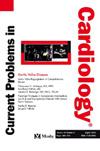Arrhythmic mitral valve prolapse: In which patients should primary prevention of sudden cardiac death be considered and how should it be implemented?
IF 3.3
3区 医学
Q2 CARDIAC & CARDIOVASCULAR SYSTEMS
引用次数: 0
Abstract
Mitral valve prolapse (MVP) affects 2–3 % of the population and is generally benign. However, a subgroup presents severe complications such as ventricular arrhythmias and sudden cardiac death (SCD). Arrhythmogenic mitral valve prolapse (AMVP) combines MVP with frequent or complex ventricular arrhythmias in the absence of other causes. Although SCD in AMVP patients is rare (0.2–0.4 %, annual), it exceeds the general population rate and is associated with specific high arrhythmic risk features, such as mitral annular disjunction (MAD), bileaflet prolapse, Pickelhaube sign, abnormal T waves on the electrocardiogram, and rapid non-sustained ventricular tachycardia. Primary prevention is crucial but challenged by the lack of standardized guidelines. AMVP requires a multidisciplinary and cost-effective evaluation to stratify risk and prevent SCD in a predominantly young and healthy population.
The objective of this review is to describe the variables with the highest arrhythmogenic risk in patients with MVP and the possible primary prevention strategies for sudden cardiac death.
心律失常二尖瓣脱垂:哪些患者应考虑心源性猝死的一级预防?如何实施?
二尖瓣脱垂(MVP)影响2 - 3%的人口,通常是良性的。然而,有一个亚组出现严重的并发症,如室性心律失常和心源性猝死(SCD)。心律失常源性二尖瓣脱垂(AMVP)合并MVP与频繁或复杂的室性心律失常在没有其他原因。虽然AMVP患者的SCD很少见(每年0.2 - 0.4%),但它超过了一般人群的发生率,并与特定的高心律失常风险特征相关,如二尖瓣环分离(MAD)、双小叶脱垂、Pickelhaube征、心电图异常T波和快速非持续性室性心动过速。初级预防至关重要,但由于缺乏标准化的指导方针而受到挑战。AMVP需要多学科和具有成本效益的评估,以分层风险和预防SCD,主要是年轻和健康的人群。本综述的目的是描述MVP患者致心律失常风险最高的变量以及可能的心源性猝死一级预防策略。
本文章由计算机程序翻译,如有差异,请以英文原文为准。
求助全文
约1分钟内获得全文
求助全文
来源期刊

Current Problems in Cardiology
医学-心血管系统
CiteScore
4.80
自引率
2.40%
发文量
392
审稿时长
6 days
期刊介绍:
Under the editorial leadership of noted cardiologist Dr. Hector O. Ventura, Current Problems in Cardiology provides focused, comprehensive coverage of important clinical topics in cardiology. Each monthly issues, addresses a selected clinical problem or condition, including pathophysiology, invasive and noninvasive diagnosis, drug therapy, surgical management, and rehabilitation; or explores the clinical applications of a diagnostic modality or a particular category of drugs. Critical commentary from the distinguished editorial board accompanies each monograph, providing readers with additional insights. An extensive bibliography in each issue saves hours of library research.
 求助内容:
求助内容: 应助结果提醒方式:
应助结果提醒方式:


